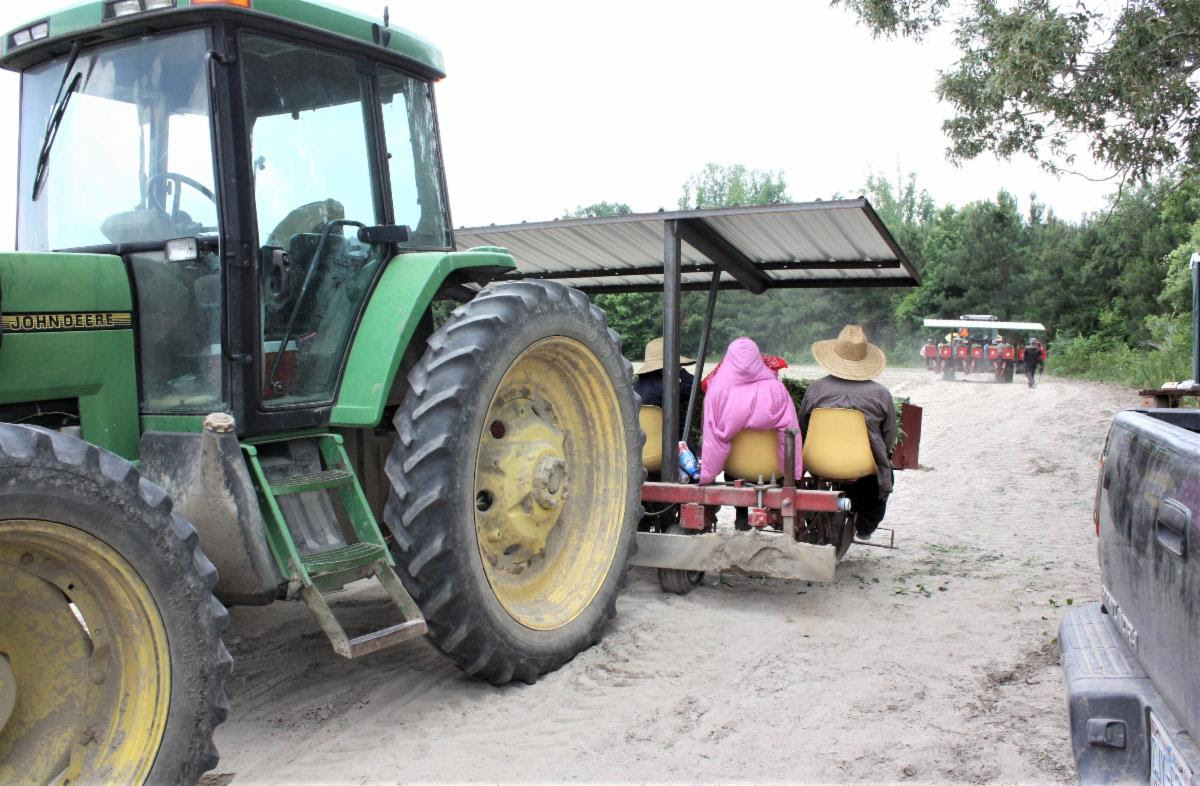Friday, May 29, 2020
Sunday, May 3, 2020
MORE THAN HALF OF FLUE ACRES SET OUT; BURLEY, DARK TRANSPLANTING JUST BEGINNING

Setting plants near Rocky Mount, N.C. File photo by the editor.
How much of the N.C. crop has been planted? "If I had to guess, I would say we have 15 to 20 percent planted by now," says Matthew Vann, N.C. Extension tobacco specialist. "Maybe 25 percent at the most. Compared to any other year, we are well behind."
Mother Nature has not been friendly to North Carolinians this season. "This crop was seeded much later than normal, then we had the worst greenhouse season in my 10 years in North Carolina," says Vann. "Once we were ready to set out, it seemed like we had a big weather event every week, and our soils remained saturated. If we can catch a week with good dry weather and moderate temperatures, we can catch up soon."
At least 75 per-cent of the flue-cured crop in South Carolina has been planted, much of it in the week just ended. Weather hasn't been favorable here either. But in the three weeks just ended, heavy planting has been going on, says Matthew Inman, S.C. Extension tobacco specialist.
In Georgia, as of April 27, essentially all of the crop was transplanted. "Only about 350 acres are left," said J. Michael Moore, Georgia Extension tobacco specialist. "However, this [acreage] belongs to a limited number of growers, and it may take until May 4 to complete the process."
Tomato spotted wilt is running only three to four percent of the Georgia stand, Moore says. All the crop was treated with Admire Pro and approximately 40 percent was also treated with an Actigard tray drench in the greenhouse. No other pest problems have been reported.
Connecticut broadleaf picks up in popularity in Kentucky and Tennessee: After an apparently rewarding test crop in 2019, farmers in the Black Patch are planting significantly more Connecticut broadleaf this season. "There could be 2,500 acres or more grown in Kentucky and Tennessee this year," says Andy Bailey, Extension dark tobacco specialist for Kentucky and Tennessee.
 You really need to produce wrapper grades with this type. "Broadleaf that earned a wrapper grade last year sold for $4 to $6 per pound," says Bailey. "But for leaf that doesn't get a wrapper grade, the price offered is less than for burley." You really need to produce wrapper grades with this type. "Broadleaf that earned a wrapper grade last year sold for $4 to $6 per pound," says Bailey. "But for leaf that doesn't get a wrapper grade, the price offered is less than for burley."
Slightly earlier than normal start for K-T transplanting: Transplanting in the Black Patch typically doesn't begin till May 1, but a little was planted early this season, says Bailey. "For instance, one grower in Logan County, Ky., was able to set out nine acres last Tuesday (April 28), and he wanted to plant some more on Friday."
But the dark that was planted in April made up less than one percent of the crop, Bailey says. Planting will get started in earnest next week and especially the week from May 11 to 18. "Much of the dark-fired crop is double cropped--an early crop is set in early-to mid-May and a late crop is set in mid-June so that both crops can be cured back to back in the same barn."
The dark types took a beating in contracting. US Smokeless Tobacco cut contracts drastically, with dark fire-cured reduced 45 percent and dark air-cured 48 percent. American Snuff, the number two buyer of the dark types, was reportedly unchanged in its contract. Bailey estimates dark fired plantings at 12,000 acres and dark air plantings at four to 5,000 acres.
About 11 percent of Kentucky's burley greenhouses remained to be seeded as of April 26, USDA said. Thirty-seven percent of transplants were under two inches, with 44 percent two to four inches, and 19 percent above four inches. Little if any had been taken to the field.
REPORT FROM OVERSEAS
ZIMBABWE: Tobacco sales here began last week after a month-long delay due to a general lockdown ordered by the government to contain the COVID-19 virus. The lockdown continues, but tobacco marketing has been exempted on condition that everyone involved observes recommendations to reduce infections. One suggestion: The national agriculture minister proposed restructuring deliveries to the floors to minimize the number of the human traffic coming to the markets and to reduce transport costs paid by the farmer.
Fewer growers: The Zimbabwean Tobacco Industry Marketing Board reported that the number of registered growers is 148,084 this year compared to 178,721 in 2019. Plantings are estimated down 12 percent, from 133,000 hectares in the 2019 season to to 117,000 for the current season.
|
Subscribe to:
Posts (Atom)





